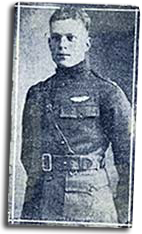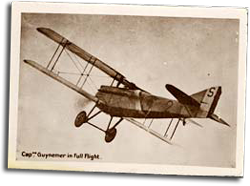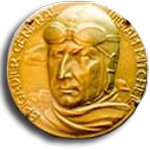 Lieutenant Hugh Broomfield flew an observation plane in France. (OSA)
Lieutenant Hugh Broomfield flew an observation plane in France. (OSA)
A Pilot in the Making
The year after Irishman Thomas Broomfield became a U.S. citizen in 1895, he saw the birth of his son, Hugh Dent Garvin Broomfield, in Illinois. The family soon moved to Minnesota, where Hugh graduated early from high school in 1912. After attending three other colleges and spending a brief time teaching school in North Dakota, he earned a degree in 1917 from Reed College in Portland.
The same day war was declared on April 6, 1917, Hugh Broomfield took the physical examination to enlist in the Army Reserve Corps. He entered the first officers' training camp at the Presidio in San Francisco, California in May. After three months he was asked to transfer to the aviation section of the Signal Reserve Corps. By October, Broomfield completed aviation school in nearby Berkeley, California and boarded a ship for duty in France as a second lieutenant.
Over France
Over the next months, he served in several areas in France and earned a promotion to first lieutenant. By the summer of 1918, Broomfield joined the 90th Aero Squadron of the American Expeditionary Force, just before the St. Mihiel offensive in September. He controlled the field operations for the squadron. As such, he oversaw the prompt departure of all air missions during the offensive. On the field from dawn until dark, he helped the squadron fly an unusually high number of missions.
After the offensive, Broomfield began his service as a pilot in the squadron. He flew frequent missions over the next several weeks in bad weather and under enemy fire from the ground. His job was to enable his observer to bring back the most complete and accurate reconnaissance of the enemy's strengths and movements.
Urgently Needed
The corps commander sent a message to the squadron on October 21 during an offensive at Verdun, one of the bloodiest battlefields of the war. He urgently needed a plane to penetrate the German lines and bring back information about the enemy's ability to launch a counterattack. Lt. Broomfield and his observer, Lt. Cutter, immediately volunteered for the mission and, eager to go, left the squadron's aerodrome at 10 a.m. They flew into a very dangerous sky. The low-lying clouds gave the advantage of surprise attack to the enemy planes and ground machine guns since Broomfield was forced to fly at very low altitude. Dodging enemy fire, the two lieutenants made it over the German lines and began observations.
Meanwhile, back at squadron headquarters, flight commander Norris Pierson waited for the mission to return. They should have been back by noon. Pierson waited as the afternoon began. He called all of the balloon and ground units he could reach by telephone. They reported an American plane had been seen falling at 11:15 a.m. behind the German lines. While anxious about the news, Pierson called off his investigation, hoping to hear the pair was safe, even if prisoners. But he heard nothing.
"There Is No Question About Their Identity"
About two weeks later, the Allied offensive moved forward into the territory that had been held by the Germans. Pierson distributed 500 circulars describing the plane and asking for help in locating it. He soon heard by telephone about a wrecked plane in the area Broomfield's had been thought to fall. The squadron surgeon volunteered to investigate. And, despite the continued danger from enemy artillery in the area, Broomfield's loyal chief mechanic begged to go. The next day they found the plane and identified the bodies.
Two days later Lt. Pierson attended the funeral and burial services. The only available chaplain was Catholic. Adapting to the situation, Pierson asked the "excellent and broad-minded" priest to read the Protestant service from Pierson's Episcopal prayer book. Before he left, Pierson also made sure Broomfield's headstone had the proper inscription and noted its location:
The Honors Flow
 Distinguished Service Cross
Distinguished Service Cross
Early the next year, the U.S. government posthumously awarded the Distinguished Service Cross to Broomfield in recognition of his "extraordinary heroism in action on the day he met his death."
In the fall of 1919, the Portland City Council passed an ordinance that gave Broomfield's name to the city's aviation field to honor "his work at the front as a daring and skillful pilot." Within two years, the Broomfield Aviation Field was slated to be abandoned. His parents, while disappointed with the planned closure, were still proud of their son. They wanted "the naming of the first field to be part of his history as recorded in his state." It was important to the mother who wrote: "We have had so much sickness and misfortune in the family since the boy went away...."
In the spring of 1920, the Bethany Baptist Church near his parents' house on Tacoma Avenue in southeast Portland dedicated a tablet, or memorial marker, to Hugh Broomfield. Mr. and Mrs. Broomfield may have taken some solace from the earlier remarks of Lieutenant Foster, a squadron friend, who remembered that "Hugh had spent some time reading his Testament the night before the loss."
 French aerial ace Georges Guynemer flies off to engage the enemy. Out of 600 combat missions, he was shot down seven times and recorded 54 victories before he was killed in 1917. German pilot Manfred von Richtofen, also known as the "Red Baron," had 80 victories, the most in WWI, before he was killed in 1918. Top American ace, Eddie Rickenbacker had 26 victories. (OSA, Oregon Defense Council Records, Photos, Box 2)View airplane and pilot photographs.View observation balloon photographs.
French aerial ace Georges Guynemer flies off to engage the enemy. Out of 600 combat missions, he was shot down seven times and recorded 54 victories before he was killed in 1917. German pilot Manfred von Richtofen, also known as the "Red Baron," had 80 victories, the most in WWI, before he was killed in 1918. Top American ace, Eddie Rickenbacker had 26 victories. (OSA, Oregon Defense Council Records, Photos, Box 2)View airplane and pilot photographs.View observation balloon photographs.
War in the Sky
Broomfield's aviation career was not unlike those of many others during World War I. It was short, required great skill and courage, and ended in his death. When the war began in 1914, airplanes were still relatively primitive. Many airplanes were general use "pusher" models, similar in configuration to the plane first flown by the Wright Brothers just over a decade before. Some commanders were skeptical of their utility. But airplanes quickly proved themselves in battle. They combined with observation balloons to help determine the capabilities of the enemy.
By the time of the American involvement in the war, great strides had been made in aviation technology, strategy, and tactics. Specialized airplanes such as fighters and bombers evolved rapidly. In addition to the observation duties, by the end of the war airplanes engaged in strategic and tactical bombing, ground attack, and naval warfare.
A Growing Role for Air Power
However, despite the rapid improvements, the airplane did not play the decisive role in World War I that it was destined to play in World War II and subsequent wars. Still, by the end of the war, it was clear to many its time had come. One of these believers, U.S. Army Brigadier-General Billy Mitchell, tirelessly promoted the potential of air power to revolutionize war. As a major in the early stages of the American involvement in World War I, he argued that General Pershing should build a large air force within the American Expeditionary Force. Pershing agreed and put Mitchell in charge of organizing and training the American pilots.
 Congress awarded this medal to Billy Mitchell in 1946. (National Air and Space Museum)
Congress awarded this medal to Billy Mitchell in 1946. (National Air and Space Museum)
The war ended before he could prove his theories about the importance of strategic bombing. In later years, the blunt and outspoken Mitchell alienated much of the leadership in the Army by pushing for an independent role for the air force. He won no friends in the Navy by his claims that surface naval fleets were effectively obsolete. Finally, after frequent clashes, Mitchell was demoted and later court martialed for insubordination. He resigned in 1926 and died ten years later during a period when his ideas were largely ignored and U.S. air power had withered.
Just a few years later, World War II proved Mitchell's theories and Congress soon vindicated him, posthumously awarding him the Special Congressional Medal of Honor in 1946. Moreover, by 1947, his dream of a separate air force branch of the military came to fruition with the creation of the United States Air Force.
Notes
(Oregon State Defense Council Records, Personal Military Service Records, World War I, Broomfield: Box 2, Clackamas County, School District No. 115; Hoffman: Box 7, Wasco County, School District No. 12)